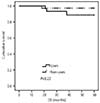1. Ferlay J, Soerjomataram I, Dikshit R, Eser S, Mathers C, Rebelo M, et al. Cancer incidence and mortality worldwide: sources, methods and major patterns in GLOBOCAN 2012. Int J Cancer. 2015; 136:E359–E386.

2. Oh CM, Won YJ, Jung KW, Kong HJ, Cho H, Lee JK, et al. Cancer statistics in Korea: incidence, mortality, survival, and prevalence in 2013. Cancer Res Treat. 2016; 48:436–450.

3. Fujiwara H, Yokota H, Monk B, Treilleux I, Devouassoux-Shisheboran M, Davis A, et al. Gynecologic Cancer InterGroup (GCIG) consensus review for cervical adenocarcinoma. Int J Gynecol Cancer. 2014; 24:S96–101.

4. MacLennan A, Lester S, Moore V. Oral estrogen replacement therapy versus placebo for hot flushes: a systematic review. Climacteric. 2001; 4:58–74.

5. Rossouw JE, Anderson GL, Prentice RL, LaCroix AZ, Kooperberg C, Stefanick ML, et al. Risks and benefits of estrogen plus progestin in healthy postmenopausal women: principal results From the Women's Health Initiative randomized controlled trial. JAMA. 2002; 288:321–333.
6. Irie T, Kigawa J, Minagawa Y, Itamochi H, Sato S, Akeshima R, et al. Prognosis and clinicopathological characteristics of Ib-IIb adenocarcinoma of the uterine cervix in patients who have had radical hysterectomy. Eur J Surg Oncol. 2000; 26:464–467.

7. Masood S, Rhatigan RM, Wilkinson EW, Barwick KW, Wilson WJ. Expression and prognostic significance of estrogen and progesterone receptors in adenocarcinoma of the uterine cervix. An immunocytochemical study. Cancer. 1993; 72:511–518.

8. Bodner K, Laubichler P, Kimberger O, Czerwenka K, Zeillinger R, Bodner-Adler B. Oestrogen and progesterone receptor expression in patients with adenocarcinoma of the uterine cervix and correlation with various clinicopathological parameters. Anticancer Res. 2010; 30:1341–1345.
9. Parazzini F, La Vecchia C. Epidemiology of adenocarcinoma of the cervix. Gynecol Oncol. 1990; 39:40–46.

10. Everhov AH, Nyberg T, Bergmark K, Citarella A, Rådestad AF, Hirschberg AL, et al. Hormone therapy after uterine cervical cancer treatment: a Swedish population-based study. Menopause. 2015; 22:633–639.
11. O'Donnell RL, Clement KM, Edmondson RJ. Hormone replacement therapy after treatment for a gynaecological malignancy. Curr Opin Obstet Gynecol. 2016; 28:32–41.
12. Biglia N, Maffei S, Lello S, Nappi RE. Tibolone in postmenopausal women: a review based on recent randomised controlled clinical trials. Gynecol Endocrinol. 2010; 26:804–814.

13. Lee KB, Lee JM, Lee JK, Cho CH. Endometrial cancer patients and tibolone: a matched case-control study. Maturitas. 2006; 55:264–269.

14. Lee KB, Lee JM, Yoon JH, Park CY. The safety of tibolone in epithelial ovarian cancer patients. Maturitas. 2006; 55:156–161.

15. Ploch E. Hormonal replacement therapy in patients after cervical cancer treatment. Gynecol Oncol. 1987; 26:169–177.

16. Lacey JV Jr, Brinton LA, Barnes WA, Gravitt PE, Greenberg MD, Hadjimichael OC, et al. Use of hormone replacement therapy and adenocarcinomas and squamous cell carcinomas of the uterine cervix. Gynecol Oncol. 2000; 77:149–154.








 PDF
PDF ePub
ePub Citation
Citation Print
Print





 XML Download
XML Download